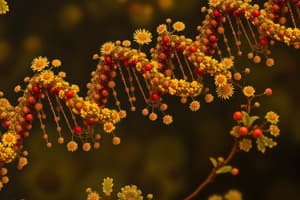Podcast
Questions and Answers
What is the primary function of WT1 in mammals?
What is the primary function of WT1 in mammals?
- Producing hormones
- Facilitating cell division
- Controlling gene expression (correct)
- Regulating protein synthesis
Mis-regulation of transcription factor expression can result in diseases and malformations.
Mis-regulation of transcription factor expression can result in diseases and malformations.
True (A)
Name one experimental method used to investigate transcription factors.
Name one experimental method used to investigate transcription factors.
ChiP or CUT and RUN
Transcription factors can be purified by __________ chromatography, utilizing their ability to bind specific DNA sequences.
Transcription factors can be purified by __________ chromatography, utilizing their ability to bind specific DNA sequences.
Match the experimental method to its description:
Match the experimental method to its description:
Which of the following is NOT a method used to investigate transcription factors?
Which of the following is NOT a method used to investigate transcription factors?
What is the primary role of dimerization in transcription factors?
What is the primary role of dimerization in transcription factors?
The recognition helix in homeodomain proteins determines DNA binding specificity.
The recognition helix in homeodomain proteins determines DNA binding specificity.
Name one example of a transcription factor involved in muscle development.
Name one example of a transcription factor involved in muscle development.
Homeodomain proteins form _____ alpha helices including the helix turn helix motif.
Homeodomain proteins form _____ alpha helices including the helix turn helix motif.
What type of structure do zinc fingers utilize for their stability?
What type of structure do zinc fingers utilize for their stability?
Leucine zippers can form both homodimers and heterodimers.
Leucine zippers can form both homodimers and heterodimers.
What connects the zinc finger motifs in transcription factors?
What connects the zinc finger motifs in transcription factors?
Match the following elements with their descriptions:
Match the following elements with their descriptions:
Which of the following activities do transcription factors NOT perform?
Which of the following activities do transcription factors NOT perform?
Transcription factors have a fixed binding specificity and cannot change.
Transcription factors have a fixed binding specificity and cannot change.
Name one protein that has histone acetylase activity.
Name one protein that has histone acetylase activity.
Transcription factors activate and repress transcription by mediating contact with __________.
Transcription factors activate and repress transcription by mediating contact with __________.
Match the transcription factor activity with its description:
Match the transcription factor activity with its description:
What is one mechanism through which transcription factors can repress transcription?
What is one mechanism through which transcription factors can repress transcription?
Histone acetylases (HATs) increase transcription by loosening chromatin.
Histone acetylases (HATs) increase transcription by loosening chromatin.
What is the primary function of insulators in gene regulation?
What is the primary function of insulators in gene regulation?
Identify the role of histone deacetylases (HDACs).
Identify the role of histone deacetylases (HDACs).
Housekeeping genes are only found in specific types of cells.
Housekeeping genes are only found in specific types of cells.
Name one transcription factor motif classified as a structural motif.
Name one transcription factor motif classified as a structural motif.
Cis-regulatory sequences include enhancers and ________.
Cis-regulatory sequences include enhancers and ________.
Match the transcription factors with their respective motifs:
Match the transcription factors with their respective motifs:
How do transcription factors boost transcription efficiency?
How do transcription factors boost transcription efficiency?
Tissue-specific genes contain binding sites only for tissue-specific transcription factors.
Tissue-specific genes contain binding sites only for tissue-specific transcription factors.
What primarily determines when a specific gene is expressed?
What primarily determines when a specific gene is expressed?
Which of the following best defines a transcription factor?
Which of the following best defines a transcription factor?
Specific transcription factors are involved in the formation of the basal transcription complex.
Specific transcription factors are involved in the formation of the basal transcription complex.
How many human transcription factors have been identified?
How many human transcription factors have been identified?
Transcription factors often bind as ______ to modulate the binding frequency.
Transcription factors often bind as ______ to modulate the binding frequency.
Match the following types of transcription factors with their functions:
Match the following types of transcription factors with their functions:
What is a common mechanism used by transcription factors for gene activation?
What is a common mechanism used by transcription factors for gene activation?
Transcription factors can access DNA easily because it is loosely wrapped around nucleosomes.
Transcription factors can access DNA easily because it is loosely wrapped around nucleosomes.
What do transcription factors bind to in order to regulate transcription?
What do transcription factors bind to in order to regulate transcription?
Flashcards are hidden until you start studying
Study Notes
Definition and Types of Transcription Factors
- Transcription factors (TFs) are proteins essential for initiating or regulating transcription, acting outside of RNA polymerase.
- General (basal) transcription factors form the core transcription complex at the promoter (e.g., TFIID).
- Specific transcription factors regulate the expression of particular genes by binding to regulatory sequences, leading to selective protein synthesis.
- Approximately 1639 human transcription factors have been identified, indicating a complex transcriptional regulatory landscape.
General Principles of TF Binding
- TFs bind to DNA through weak interactions, requiring 10-20 such interactions to effectively stabilize DNA-protein interfaces.
- DNA tightly wrapped around nucleosomes presents a barrier to TF access, necessitating specialized mechanisms for binding.
- Higher specificity in binding is achieved through:
- Multiple weak interactions within binding sites.
- Chromatin remodelers that reposition nucleosomes.
- Dimerization of TFs in solution to modulate binding frequency.
Cis-Regulatory Sequences and Their Role
- Cis-regulatory elements such as enhancers, silencers, and insulators influence gene expression.
- Enhancers and silencers, located away from the promoter, regulate transcription by binding specific TFs.
- Insulators prevent interference between neighboring genes, allowing precise gene regulation.
Housekeeping Genes vs. Tissue-Specific Genes
- Housekeeping genes are universally expressed and contain binding sites for ubiquitous TFs across all tissues.
- Tissue-specific genes utilize both ubiquitous and tissue-specific TFs, dictating precise expression patterns based on binding site combinations.
- Combinatorial control integrating multiple factors at the pre-initiation complex (PIC) determines final transcription outcomes.
Structural Motifs of Transcription Factors
- Four primary structural motifs classify TFs:
- Helix-turn-helix: Common in various TFs, involves 2 α-helices connected by a turn; recognition helix binds in the major groove.
- Zinc fingers: Structures stabilized by zinc ions, allowing interaction with DNA; diverse and can be combined in proteins for higher specificity.
- Leucine zippers: Form coiled-coil dimers; allow dimerization through hydrophobic interactions and bind the major groove via basic amino acid stretches.
- Helix-loop-helix: Dimerization enables DNA binding; involved in muscle development and neurogenesis.
Mechanisms of Transcriptional Activation and Repression
- TFs can activate transcription through:
- Recruitment of general TFs or RNA polymerase II.
- Modifying histone structures via chromatin remodeling enzymes.
- Increasing RNA polymerase II activity to enhance transcription efficiency.
- TF repression mechanisms include:
- Directly blocking activators.
- Binding to nearby sites and preventing effective activation by hindering the activation domain.
Regulated Expression and Inducible Gene Expression
- Spatio-temporal control of TF expression facilitates diverse gene expression patterns across cell types.
- Misregulation of TF activity can result in disease and developmental malformations.
Experimental Methods to Investigate TFs
- Protein purification: Techniques such as affinity chromatography isolate TFs based on their DNA-binding properties.
- Footprinting techniques: Identify gene-specific binding via detecting the physical presence of TFs on DNA.
- Reporter gene assays: Analyze TF activity through genetic constructs linked to measurable reporter genes.
- ChIP or CUT&RUN: Techniques to analyze TF binding to DNA in vivo.
- Knock-down assays: Assess the impact of eliminating specific TFs on overall gene expression.
- AI-based motif prediction: Utilize machine learning to predict TF binding sites by comparing against known motifs.
Studying That Suits You
Use AI to generate personalized quizzes and flashcards to suit your learning preferences.




